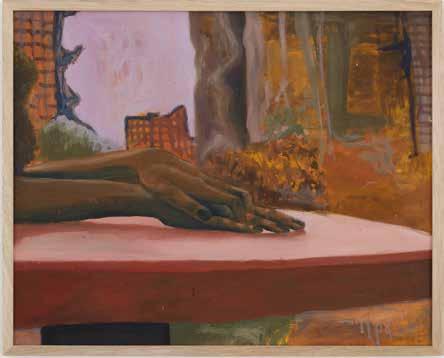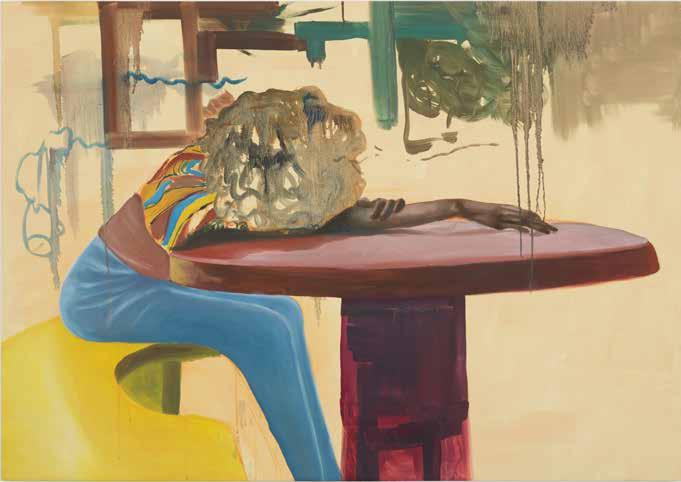
2 minute read
Rebeca Miguel
A obra em questão faz parte da série de pinturas Mãos que (des)cansam, que evoca a relação existente entre o ócio e o cansaço trazendo essa parte do corpo que é fazedora de coisas. Por meio da transparência, do escorrido e da mancha, Rebeca Miguel coloca em fragmentos os espaços de tempo em que o descanso de pessoas como Ponciá - de Conceição Evaristo - possa existir. A pintura existe em sua materialidade enquanto uma continuidade do tempo-espaço em que o descanso se coloca como pequenos fragmentos do presente.
The work in question is part of the series of paintings Mãos que (des)cansam (Rested/ Tired Hands), which evokes the relationship between idleness and tiredness, especially highlighting this part of the body that makes things. Through transparency, dripping, and staining, Rebeca Miguel puts into fragments the spaces of time in which the rest of people like Ponciá - by Conceição Evaristo - can exist. The painting exists in its materiality as a continuity of a timespace in which rest is understood as a small fragment of the present.
Advertisement
Por meio da pintura O (des)canso de Ana, Rebeca Miguel traz o ócio enquanto ato de resistência. A artista usa da linguagem pictórica para questionar as estruturas sociais nas quais mulheres negras não têm direito ao descanso. Ao retratar mulheres do atual convívio - como Ana - em momentos de descanso, ela traz um ócio desprovido de inércia, que se faz presente também pelas manchas na parte superior da pintura. A transparência e o inacabado aparecem como elementos que trazem uma dualidade provocada pelos atravessamentos de toda uma vivência.
Through the painting O (des)canso de Ana (Ana’s Rest/Tiredness), Rebeca Miguel suggests idleness as an act of resistance. The artist uses her pictorial language to question the social structures in which black women have no right to rest. By depicting women currently in her life - like Ana - in these rare moments, she highlights an idleness devoid of inertia, which is also made present by the stains on the upper part of the painting. Transparency and an unfinished aspect to her work appear as elements that propose a duality provoked by the crossings of an entire experience.

Rebeca Miguel nasceu em Belo Horizonte, onde vive e trabalha. Por meio da linguagem pictórica, (re)visita suas memórias de infância numa tentativa de reconstrução do passado e coloca o ócio enquanto ato de resistência. Em 2022, abre a individual Me canso no (des)canso dela, na Galeria Godarc, mesmo ano em que participou do 50° Salão de Arte Contemporânea Luiz Sacilotto, em São Paulo e integrou as coletivas De corpo e tinta, no Espaço Arteducação da FaE/UFMG e Quintais, na Galeria Quartoamado.
Rebeca Miguel was born in Belo Horizonte, where she lives and works. Through pictorial language, she (re)visits her childhood memories in an attempt to reconstruct the past, and proposes idleness as an act of resistance. In 2022 she presented her solo exhibition Me canso no (des)canso dela (I get tired from her rest) at Galeria Godarc, the same year in which she took part in the 50th Luiz Sacilotto Contemporary Art Salon in São Paulo, and the collective exhibitions De corpo e tinta (Of Body and Paint) at the Espaço Arteducação of FaE/UFMG, and Quintais (Backyards) at Galeria Quartoamado.










